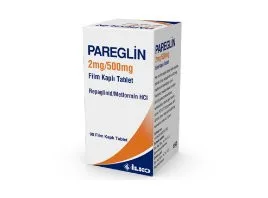- Your cart is empty
- Continue Shopping
Product
- Canadian Pharmacy Online Pharmacy | Online Canadian Pharmacy
- Need More Information Call Us 1-833-356-6337
Paraglin 2mg Replaglinide 500mg Metformin Canada Pharmacy
What is Pareglin?
Pareglin are oral diabetes medications that help control blood sugar levels. Repaglinide (Pareglin) works by causing the pancreas to produce insulin. Metformin (Pareglin) works by decreasing glucose (sugar) production in the liver and decreasing absorption of glucose by the intestines.
The combination of Pareglin is used together with diet and exercise to treat type 2 diabetes.
Pareglin may also be used for other purposes not listed in this medication guide.
Pareglin indications
Pareglin is indicated as an adjunct to diet and exercise to improve glycemic control in adults with type 2 diabetes mellitus who are already treated with a meglitinide and Metformin (Pareglin) HCl or who have inadequate glycemic control on a meglitinide alone or Metformin (Pareglin) HCl alone.
Important Limitations of Use
Pareglin should not be used in patients with type 1 diabetes or for the treatment of diabetic ketoacidosis, as it would not be effective in these settings.
How should I use Pareglin?
Use Pareglin as directed by your doctor. Check the label on the medicine for exact dosing instructions.
- An extra patient leaflet is available with Pareglin. Talk to your pharmacist if you have questions about this information.
- Take Pareglin by mouth at least 15 to 30 minutes before each meal. If you skip a meal, do not take the dose for the skipped meal.
- Take Pareglin on a regular schedule to get the most benefit from it. Taking Pareglin at the same time each day will help you remember to take it.
- Continue to take Pareglin even if you feel well. Do not miss any doses.
- If you miss a dose of Pareglin, skip the missed dose and go back to your regular dosing schedule. Do not take 2 doses at once.
Ask your health care provider any questions you may have about how to use Pareglin.
Pareglin dosage
Generic name: Repaglinide (Pareglin) 1mg, Metformin (Pareglin) HYDROCHLORIDE 500mg
Dosage form: tablet
The information at Drugs.com is not a substitute for medical advice. Always consult your doctor or pharmacist.
Recommended Dosing
The dosage of Pareglin should be individualized on the basis of the patient’s current regimen, effectiveness and tolerability. Pareglin can be administered 2 to 3 times a day up to a maximum daily dose of 10 mg Repaglinide (Pareglin)/2500 mg Metformin (Pareglin) HCl. No more than 4 mg Repaglinide (Pareglin)/1000 mg Metformin (Pareglin) HCl should be taken per meal. Initiation and maintenance of combination therapy with Pareglin should be individualized to the patient, and at the discretion of the health care provider. Blood glucose monitoring should be performed to determine the therapeutic response to Pareglin.
Pareglin doses should usually be taken within 15 minutes prior to the meal but the timing can vary from immediately preceding the meal up to 30 minutes before the meal. Patients who skip a meal should be instructed to skip the Pareglin dose for that meal.
Patients Inadequately Controlled with Metformin (Pareglin) HClMonotherapy
If therapy with a combination tablet containing Repaglinide (Pareglin) and Metformin (Pareglin) HCl is considered appropriate for a patient with type 2 diabetes mellitus inadequately controlled with Metformin (Pareglin) HCl alone, the recommended starting dose of Pareglin is 1 mg Repaglinide (Pareglin)/500 mg Metformin (Pareglin) HCl administered twice daily with meals, with gradual dose escalation (based on glycemic response) to reduce the risk of hypoglycemia with Repaglinide (Pareglin).
Patients Inadequately Controlled with MeglitinideMonotherapy
If therapy with a combination tablet containing Repaglinide (Pareglin) and Metformin (Pareglin) HCl is considered appropriate for a patient with type 2 diabetes mellitus inadequately controlled with Repaglinide (Pareglin) alone, the recommended starting dose of the Metformin (Pareglin) HCl component of Pareglin should be 500 mg Metformin (Pareglin) HCl twice a day, with gradual dose escalation (based on glycemic response) to reduce gastrointestinal side effects associated with Metformin (Pareglin) HCl.
Patients Currently Using Repaglinide (Pareglin) and Metformin (Pareglin) HCl Concomitantly
For patients switching from Repaglinide (Pareglin) co-administered with Metformin (Pareglin) HCl, Pareglin can be initiated at the dose of Repaglinide (Pareglin) and Metformin (Pareglin) HCl similar to (but not exceeding) the patient’s current doses, then may be titrated to the maximum daily dose as necessary to achieve targeted glycemic control.
No studies have been performed examining the safety and efficacy of Pareglin in patients previously treated with other oral antihyperglycemic agents and switched to Pareglin. Any change in therapy should be undertaken with care and with appropriate monitoring as changes in glycemic control can occur.
More about Pareglin (Metformin (Pareglin) / Repaglinide (Pareglin))
- Side Effects
- During Pregnancy
- Dosage Information
- Drug Images
- Drug Interactions
- Support Group
- En Espanol
- 0 Reviews – Add your own review/rating
- Generic Availability
Consumer resources
- Pareglin
- Pareglin (Advanced Reading)
Pareglin interactions
Cationic Drugs
Cationic drugs (e.g., amiloride, digoxin, morphine, procainamide, quinidine, quinine, ranitidine, triamterene, trimethoprim, and vancomycin) that are eliminated by renal tubular secretion theoretically have the potential for interaction with Metformin (Pareglin) by competing for common renal tubular transport systems. Careful patient monitoring and dose adjustment of Pareglin and/or the interfering drug is recommended in patients who are taking cationic medications that are excreted via the proximal renal tubular secretory system.
CYP2C8 and CYP3A4 Inhibitors/Inducers
Repaglinide (Pareglin) is metabolized by CYP2C8 and to a lesser extent by CYP3A4. Drugs that inhibit 2C8 (gemfibrozil, trimethoprim, deferasirox), inhibit 3A4 (itraconazole, ketaconazole), or induce CYP2C8/3A4 (rifampin) may alter the pharmacokinetics and pharmacodynamics of Repaglinide (Pareglin). In vivo data from a study that evaluated the coadministration of gemfibrozil and Repaglinide (Pareglin) in healthy subjects showed a significant increase in Repaglinide (Pareglin) blood levels. Administration of Pareglin and gemfibrozil to the same patient is not recommended.
Repaglinide (Pareglin) exposures are increased more than 20-fold in patients taking both gemfibrozil and itraconazole.
Professional resources
- Pareglin (FDA)
Related treatment guides
- Diabetes, Type 2
Pareglin side effects
Applies to Metformin (Pareglin) / Repaglinide (Pareglin): oral tablet
As well as its needed effects, Metformin (Pareglin) / Repaglinide (Pareglin) may cause unwanted side effects that require medical attention.
Minor Side Effects
Some Metformin (Pareglin) / Repaglinide (Pareglin) side effects may not need any medical attention. As your body gets used to the medicine these side effects may disappear. Your health care professional may be able to help you prevent or reduce these side effects, but do check with them if any of the following side effects continue, or if you are concerned about them:
More common:
- Diarrhea
- vomiting
Notes:
The information in this website is intended to supplement, not substitute for, the expertise and judgment of healthcare professionals. The information is not intended to cover all possible uses, directions, precautions, drug interactions or adverse effects, nor should it be construed to indicate that use of a particular drug is safe, appropriate or effective for you or anyone else. A healthcare professional should be consulted before taking any drug, changing any diet or commencing or discontinuing any course of treatment.







